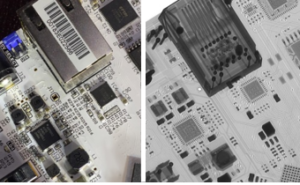10 July 2020
LACROIX Electronics
In the electronics industry, customers are increasingly demanding more and more in terms of product reliability and quality, particularly in the aeronautics, automotive and home automation sectors. In order to meet these requirements, the Electronics activity of LACROIX has implemented a high-resolution quality control process with in-line 3D laminography.
This technological breakthrough places the company among the first EMS companies to carry out an automated incline visual inspection using 3D combined with X-rays.
Meeting with Rafal Lebek, Engineering Manager at LACROIX Polish production plant, to unlock the secrets of 3D laminography, currently transforming electronic quality control processes.
Testimony
-
How does laminography enhance the reliability and quality of electronic products?
 Rafal :
Rafal :3D laminography is a non-destructive testing technique that measures the shape of soldered joints and the position of components through the combination of two technologies:
- X-ray imaging, which analyses the brazed joints, which are underneath the components, and thus not visible, to verify the reliability of the product and hence the stability of the process
- Laminography, a digital imaging technique that models the 3D volume of an object slice by slice, to verify and ensure the quality of brazed joints
We have thus trained our production teams to specify testing criteria related to laminography. In this way, the compliance of each component of an electronic board is inspected automatically to achieve the expected level of quality.
-

In this photo, on the left, an electronic board as seen with the naked eye, and on the right, the same product cut into slices, using 3D laminography.
What is the origin of this high-precision quality control technology?
 Rafal :
Rafal :Faced with the densification of electronic components and the increasing complexity of technologies, 2D radiography proved insufficient to satisfy the levels of reliability and quality demanded for industrial products.
3D laminography was therefore initially developed to meet the needs of microelectronics and component manufacturers, before being used for manufacturing electronic boards, such as those made by the Electronics activity of LACROIX for its high-tech customers.
-
Is this technology integrated with other industrial equipment?
 Rafal :
Rafal :Absolutely, it is also one of the key challenges of our Smart Industry approach: connecting machines together to optimise our industrial performance. Thus, 3D laminography is complementary to the automated optical inspection (AOI) cobot at the end of the process. In our machine fleet, these two technologies make it possible to increase the reliability of inspections of very complex electronic boards.
In the medium term, we plan to roll out this technique in the company’s other plants in France, Germany and Tunisia.
As a recent study by Deloitte shows, 40% of the price of a new car in 2020 comes from electronics. This value is expected to rise up to 50% within ten years. By way of comparison, in the 70s, this value was 5 to 10%.
This data highlights the sharp increase in the volume of electronics in sectors with high reliability requirements, which therefore need ever-more effective levels of quality control. With its testing procedures backed by X-rays and 3D technologies, the Electronics activity of LACROIX leads the way in taking these steps forward.
Plus d'articles

3 tips for reshoring through automation

Expert's take
Securing the Supply Chain: The Ideal Way to Make Your Products Last the Distance

Driving industrial projects in the electronics sector through "coopetition"

Expert's take
Design for Test: how to ensure the quality of my electronic product by optimizing its production cost?

Expert's take


